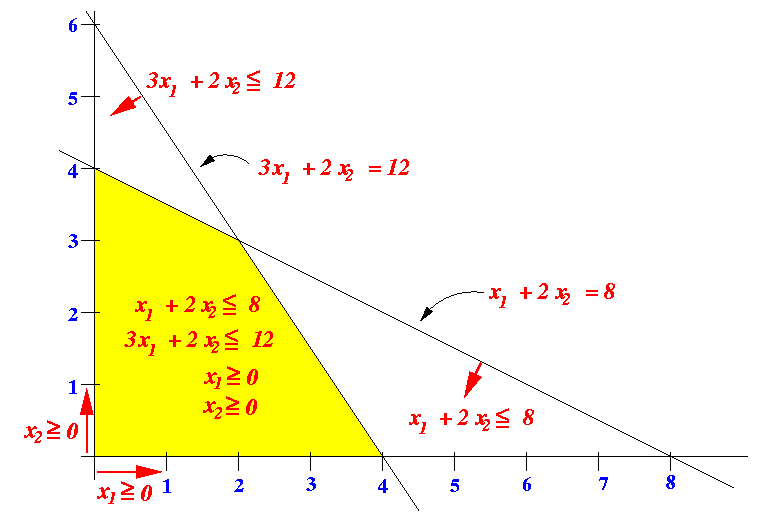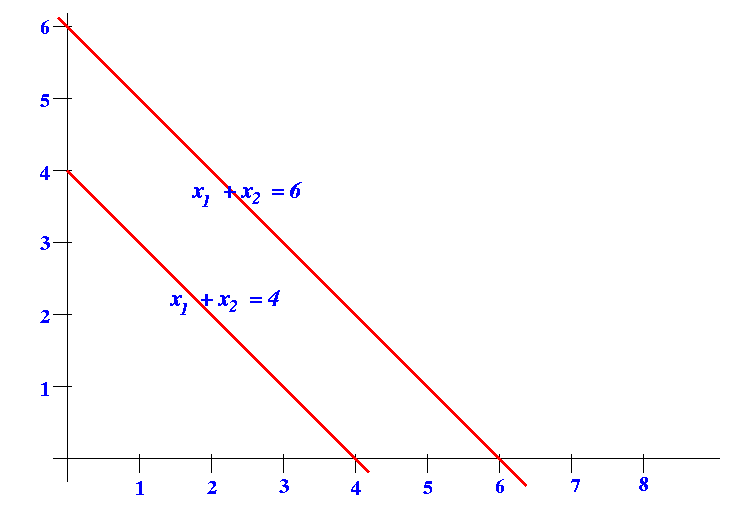- Recall:
The general form
of a constrained opimization problem:
max f( x1, x2, ..., xn ); // Objective function subject to: g1( x1, x2, ..., xn ) = c1 // Equality constraints g2( x1, x2, ..., xn ) = c2 ... gu( x1, x2, ..., xn ) = cu h1( x1, x2, ..., xn ) ≤ d1 // Inequality constraints h2( x1, x2, ..., xn ) ≤ d2 ... hv( x1, x2, ..., xn ) ≤ dv
- Linear constrained optimization:
- Linear constrained optimization
=
a constrained optimization problem
where:
- the objective function and
- the
constraint functions are:
- linear functions of x1, x2, ..., xn
- Linear constrained optimization
=
a constrained optimization problem
where:
- In other words, a
linear constrained optimization
problem looks like this:
max a1x1 + a2x2 + ... + anxn ; // Objective function subject to:c11x1 + c12x2 + ... + c1nxn ≤ d1 // Constraints c21x1 + c22x2 + ... + c2nxn ≤ d2 .... cm1x1 + cm2x2 + ... + cmnxn ≤ dm x1 ≥ 0, x2 ≥ 0, ..., xn ≥ 0 - Note:
- We do not need to use any
"="-constraints !!!
Because:
- An "="-constraint
can be re-written as
two "≤"-constaints:
ck1x1 + ck2x2 + ... + cknxn = dk is the same as: ck1x1 + ck2x2 + ... + cknxn ≤ dk ck1x1 + ck2x2 + ... + cknxn ≥ dk Or using only "≤"-constraints: ck1x1 + ck2x2 + ... + cknxn ≤ dk -ck1x1 - ck2x2 - ... - cknxn ≤ -dk
- An "="-constraint
can be re-written as
two "≤"-constaints:
- There is a trick
to transform a
linear constrained optimization problem into a form where:
x1 ≥ 0 x2 ≥ 0 ... xn ≥ 0We will learn this trick later....
- We do not need to use any
"="-constraints !!!
- Linear program
- Linear program = a linear constrained optimization problem
- Linear programming
- Linear programming = an algorithm to solve linear programs
I I I I
- Here is what a
linear
constrained optimalization problem
or Linear Program (LP) looks like:
max: x1 + x2 s.t.: x1 + 2x2 ≤ 8 3x1 + 2x2 ≤ 12 x1 ≥ 0, x2 ≥ 0
- Note:
- The constraint:
- xi ≥ 0, for every i is assumed in linear programming
So an LP is usually written as follows:
max: x1 + x2 s.t.: x1 + 2x2 ≤ 8 3x1 + 2x2 ≤ 12The constraints x1 ≥ 0, x2 ≥ 0 are implicitly assumed !!!
- The constraint:
- Given the following LP:
max: x1 + x2 s.t.: x1 + 2x2 ≤ 8 3x1 + 2x2 ≤ 12
- Feasible solution:
- A
solution
is
feasible
if it
satisfies
all constraints
- So feasibility
is only determined by
the constraints
- The objective function has nothing to do with feasibility !!!
- So feasibility
is only determined by
the constraints
- Example:
- (x1=1,
x2=0)
(or (1,0) for brevity) is
feasible because:
x1 + 2x2 = 1 + 2(0) = 1 ≤ 8 3x1 + 2x2 = 3(1) + 2(0) = 3 ≤ 12All constraints of the LP are satisfied
- (x1=1,
x2=0)
(or (1,0) for brevity) is
feasible because:
- A
solution
is
feasible
if it
satisfies
all constraints
- Feasible region:
- The feasible region =
all feasible solution
Note:
- So feasible region is only determined by the constraints !!!
Fact:
- The feasible region of
an LP is
always a
convex polyhedron
No proof, just an external reference (Wikipedia page): click here
- Example:
max: x1 + x2 s.t.: x1 + 2x2 ≤ 8 // Constraints define 3x1 + 2x2 ≤ 12 // the feasible region !The feasible region of this LP is:

The points inside the yellow colored region satisfies all the constraints:
x1 + 2x2 ≤ 8 3x1 + 2x2 ≤ 12 x1 ≥ 0 x2 ≥ 0(Remember that: x1 ≥ 0, x2 ≥ 0 are assumed !!!)
- The feasible region =
all feasible solution
- Constrained optimalization:
- Find the point (a feasible point) inside the feasible region that results in the maximum value for the objective function
- Suppose we have the following objective function:
- Obj = x1 + x2
- Some graphs (plots) depicting the
fact that
- x1 + x2 = "some constant value"
look like this:

- How to
solve this
constrained optimization problem
using graphs:
max: x1 + x2 s.t.: x1 + 2x2 ≤ 8 3x1 + 2x2 ≤ 12Answer:
- Because we want to
maximize the
objective function
"x1 + x2":
- We must find the graph for "x1 + x2 = largest constant" that lies inside the feasible region
Graphically:

We can see that:
- The optimal solution is:
x1 = 2, x2 = 3
- The maximum objective value achieved: (x1 + x2) = 5
Important note:
- The optimal solution to
an LP is
always a
"corner" point
on the edge of the
polyhedron that
makes up the
feasible region
(No proof... I can point you to some good books on the Simplex Method if you are interested)
- Because we want to
maximize the
objective function
"x1 + x2":